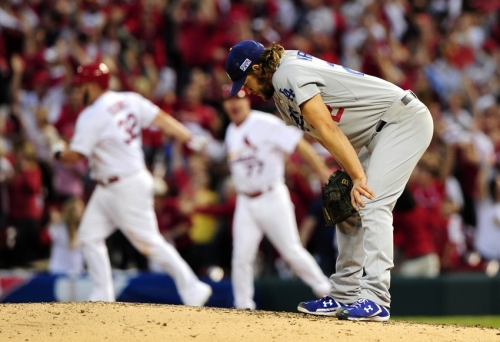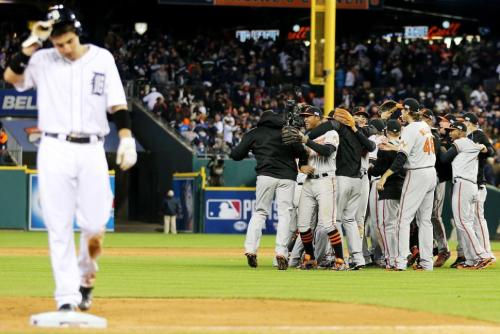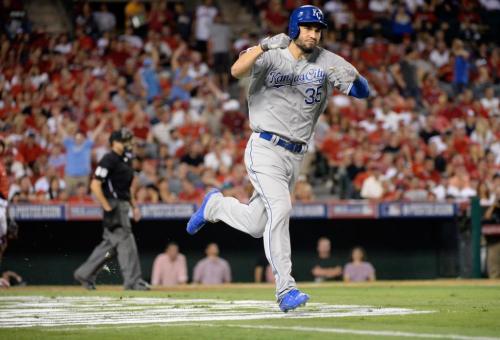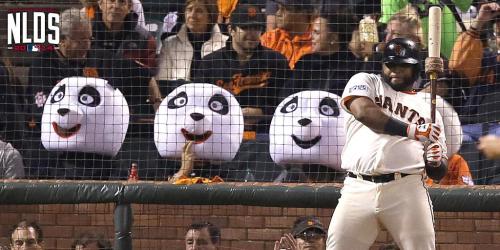Baseball is a game of inches. It’s also a game of luck. It’s also a game where your weaknesses can – and will – be magnified by those inclined to exploit them.
Let’s examine the key moment of Game Three of the NLDS between the Dodgers and Cards. You had the Dodgers with a 2-0 lead in the top of the 7th. You had Clayton Kershaw, widely accepted as the best pitcher on the planet, coming off of six innings of one run, two walk ball and 94 pitches on three days of rest. He led off the inning by giving up two singles, but didn’t appear to be struggling too badly.
Then Matt Adams came to the plate.
What happened next was a matter of:
- Inches – After going to a Kershaw hung a curveball, or a pitch that fails to break and drop the requisite number of inches as it should, resulting in a big fat target for Adams.
- Luck – Hitters have homered off of Kershaw’s curve twice in the last four years. Twice. Matt Adams promptly deposited the pitch into the bleachers for a go-ahead 3-run homer that proved to be the winning run.
- Mistakes and Weaknesses – Kershaw was throwing on three days rest because LA’s season was on the line. To that point, he was fine. However, the Dodgers bullpen prevented inept manager Don Mattingly from pulling Kershaw as he should have. Thus, Kershaw remained even as he appeared to be coasting into trouble.
Game, set, match.
We’ve cut the field of championship contenders in half over the last three days, oftentimes in as exciting a fashion as possible. There are multiple factors that contributed to the demise of the four losers, but one overarching theme stands out amongst three of the four teams: a lack of reliable bullpen pitching coupled with managerial inexperience/incompetence in terms of dealing with said weakness. (The fourth, the Angels, were probably a victim of timing – two of their losses were in extra inning games, and their elimination game might as well have been predetermined by fate. Seriously, if anyone says they expected the Royals to sweep the Angels out of Kaufmann stadium, I’m going to punch you in the face.)
Teams have gotten by without dominant closers in postseasons past, but usually have a multi-headed beast that rises to the moment sometime around August, peters out a little in September, and then goes into full lock-down mode, declaring Assault on Precinct 13-style warfare upon opposing hitters during the month of October. (Did I make that up? Yes. However, in my twenty-two years of cognizant baseball studying, I’ve observed that a championship team usually picks up a head of steam around August. Is this true? Maybe. Do I have stats? No, but for those keeping track at home, the Royals, Orioles and Giants all got hot around August this year. I’ve just blocked the Cardinals out of my brain.)
To wit:
The Dodgers put their chips on Clayton Kershaw’s shoulders as we described above, riding him hard in the Division Series. In both outings, he gave them six quality innings before collapsing in the seventh inning when he was tiring. Meanwhile, Mike Matheny of the Cardinals pulled his ace Adam Wainwright in Game One after five innings – remember, Wainwright threw a metric shit-ton of innings this year; he’s a workhorse. Why did he do that? Trustworthy bullpen that knows how to get multiple outs and isn’t reliant upon one player.
Same with the Orioles, who have Andrew Miller and Darren O’Day to eat up multiple innings at the ends of games, in addition to a full slate of quality pitchers waiting to relieve their mediocre starters. (Although I wouldn’t allow Ubaldo Jiminez anywhere near the mound in a close game – I’d sooner let a Kodiak pitch then Jiminez if I’m Buck Showalter.) The Orioles never panicked when the Tigers scored first, solely because their offense is built for scoring quickly with home runs, and they feasted upon the Tigers two-headed burro of Joba Chamberlain and Joakim Soria. Twice!
The Giants have a capable bullpen, hardly extraordinary, but they are helmed by Bruce Bochy, one of the top three tacticians in the game today (Showalter is another) and a manager who is making a Hall of Fame case this postseason. During Game Four on Tuesday night, he never blinked, making all the right moves as Matt Williams let the Nationals best relievers sit on the bench as they literally threw away the postseason on a wild pitch.
(The Royals have their own dominant bullpen, as I’ve written before about Greg Holland, Wade Davis, and Kelvim Herrera. The reason they won all those extra inning games? Gumption and luck and the Angels buying the wrong thing from the wrong sorceress in the hills of Anaheim, hell I dunno, but having a massively reliable bullpen that can get outs in bunches while their offense bunts their way into success probably didn’t hurt any.)
– A quick word about my predictions before I delve into the series previews: I’m currently 0 for 6 in the playoffs. I cannot pick a winner to save my life. That being said, two of the four teams I was rooting for managed to win not only in quick fashion, but with dominant flair. Unfortunately, they both play in the American League, forcing me to narrow who I’m rooting for to get through and win it all. After watching the LDS, I’m hoping that my picks this year are suffering from some kind of jinx-influencing curse – rational? Eh. Fun? Yes. Therefore, I’m deliberately picking the teams I don’t particularly care for so as to try and shape the outcomes into my most desired option for a World Series. If I’m right, then I get the satisfaction of saving face in my picks record. If I’m wrong, we get to watch a heck of a series that won’t involve the Cards. Either way, I win. (Which is all that matters, right? Right?) –
ALCS: Baltimore Orioles vs. Kansas City Royals
The Royals have become America’s darlings by playing their own peculiar (in this day and age, anyway) brand of baseball, but also by becoming hot at the right time. Much has been made of their failing to score 8 or more runs in a game for the last two months of the season, only to turn around and do it twice in a four game span. Part of the reason they’ve been able to do that is because Eric Hosmer and Mike “Moose Dong” Moustakas have upped their production in the postseason. Hosmer in particular has performed more than admirably over the past two months of the season, posting a .321/.379/.509 slash line since the start of July that belies his .270/.318/.398 season stats. Their bullpen is also incredible, probably second in the league only to…
…the Orioles. Kevin Gausman and LDS Game Three hero Zach Britton join Miller and O’Day to form Showalter’s lockdown pen. Meanwhile, Adam Jones, Nelson Cruz, and Steve Pearce (and Chris Davis, who can return from a 25-game suspension after Game Four) form a powerful heart to Baltimore’s line-up that hit more than twice as many home runs as the Royals over the course of the season. Kansas City has the rotation edge, but in my opinion, both teams cancel each other out there, even though Kansas City has “Big Game” James Shields, the Astronaut Lion.
The Royals are faster and better pure hitters, while Baltimore will hit for more power. As far as leadership goes – if it goes anywhere – Buck Showalter is a better manager than everybody Ned Yost. In a series of games potentially decided by inches and as a fan with no true vested interest in either team, I hate to go against the Royals…but as I mentioned before, I plan on winning this either way. The pick: Orioles in six
NLCS: St. Louis Cardinals vs. San Francisco Giants
Meanwhile, the Lesser Championship Series pits the Cardinals and Giants against each other…again. (Flashbacks to 2012) These two teams are the class of the National League, winning year after year. This is the rough equivalent of the glory days of Indianapolis and New England facing off year after year in the AFC Championship over in the NFL, though without the marquee names. (At least, not since Albert Pujols fled for Anaheim and mediocrity while Tim Lincecum was abducted by aliens and replaced with the lesser version of latter-day Kerry Wood…which is saying something.) Both teams are what might be called ‘scrappy’ by the less imaginative, and ‘teams that play the right way’ by older folks. What they really are is just plain good.
The Cardinals are led by Matts, with Carpenter, Holliday, and Adams each coming through at key moments throughout the postseason so far. Adam Wainwright anchors a tough pitching rotation, and the bullpen is feisty. Meanwhile, the Giants feature an offense with multiple Brandons (Belt and Crawford, respectively), a Buster (Posey), and a Panda (local hero Pablo Sandoval, he of the three-homer game in 2012). After Madison Bumgarner, the rotation falls off a bit, though Tim Hudson (this is the furthest Tim Hudson has gone in any postseason in his career!), Jake Peavy, and Ryan Vogelsong are all a different variation of sturdy/serviceable. Their bullpen has been in flux throughout the year, but Bruce Bochy isn’t afraid to use them to his advantage – and we all know what Lincecum can do when coming off the bench.
In the end, this is a series that will be really close to call. Bochy has made his case as a Hall of Fame manager this year, and his expertise will be a factor in multiple games, but the Cardinals have home field advantage, have a seasoned, experienced lineup that has performed better so far, and a more complete pitching staff. Although, as I’ve mentioned before, if I’m wrong here, technically I still win. So there’s that. The pick: Cardinals in six. <vomits>
Play ball.










